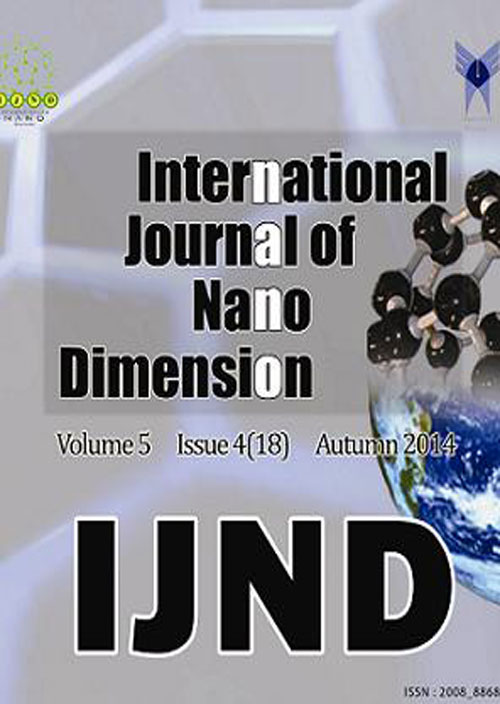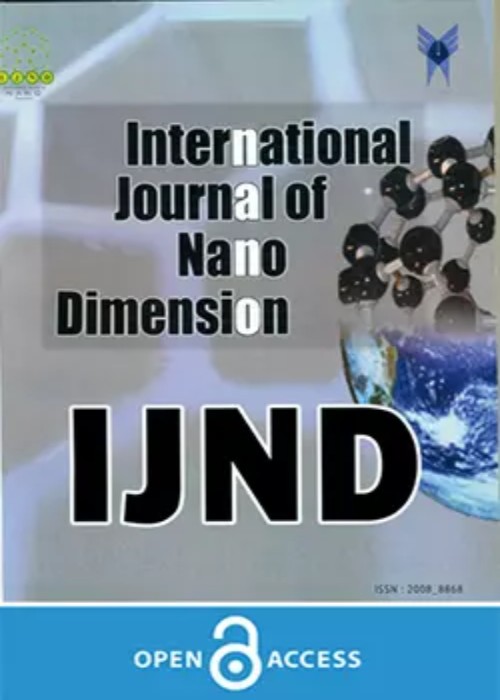فهرست مطالب

International Journal of Nano Dimension
Volume:12 Issue: 4, Autumn 2021
- تاریخ انتشار: 1400/05/30
- تعداد عناوین: 10
-
-
Pages 310-327
Cancer prevails to be one of the main reasons of death across the globe. A large group of drugs and other therapies exist in the market for cancer treatment, yet, these conventional therapies have huge drawbacks such as low-specificity, off-target toxicity, and multidrug resistance that impact the standard of living of the patients. The concept of nanomedicine for targeted cancer therapy was able to overcome these problems, enhance the antitumor activity, and reduce systemic toxicity. Nanomedicine aims at utilizing properties of materials in the range of 1 to 100 nm for the treatment of diseases. Nanomedicine can achieve targeted therapy owing to the uncommon properties of nanoparticles and cancer itself. Cancer nanomedicine is used not only for treatment but its potential can also be expanded for early cancer diagnosis and tumor imaging. Many nanomedicines are currently in various phases of clinical trials and a few have already been authorized by the Food and Drug Administration for clinical use. This review highlights different approaches to targeted delivery of drugs and summarizes the utilization of various nanoparticles in targeted drug delivery, combination therapy, diagnosis, and imaging. Finally, this review also discusses the challenges that need to be overcome and provides an insight into future perspectives in the area of cancer nanomedicine.
Keywords: Antitumor activity, cancer, Drug delivery, Nanomedicine, Targeted Therapy -
Pages 328-334In present research, we synthesized cobalt-based silica nanocomposites (Co-SiO2) from cobalt nitrate [Co(NO3)2] and tetraethoxysilane (TEOS) precursors by using a simple sol-gel method followed by supercritical drying techniques. The physicochemical and textual properties of the as synthesized nano composites were thoroughly investigated. The results indicated that the Co-SiO2 aerogels demonstrated homogeneous dispersion cobalt nanoparticles within silica matrix with mesoporous morphology, large specific surface area (802 m2/g) and larger pore size (9 nm) with less volume shrinkage. The physico-chemical properties of the cobalt based silica nanomaterial were characterized by XRD, SEM, N2 adsorption-desorption and FTIR techniques. Cobalt-based silica nanocomposites can be produced using TEOS-based precursor and supercritical drying techniques. The prepared (Co-SiO2) nanocatalyst due to its magnetic nature with higher surface area (802 m2/g) can be utilized in many emerging fields such as catalysis, water desalination, water splitting, gas-sensing application and organic pollutant degradation.Keywords: Aerogel, Cobalt-Silica Nanocomposites, Nanocatalysts, Sol-gel process, Supercritical Drying
-
Pages 335-342By applying B3LYP/6-31G* time dependent density functional level of theory and sum-over-state (SOS) approach, the static and frequency dependent polarizability and second hyperpolarizability properties of the , , and cages have been studied. The polarizability and second hyperpolarizability properties of cage have been studied by considering effects of Li, Na and K atoms encapsulation in the cage. The type and encapsulation of M atom can greatly impress onpolarizabilities and second hyperpolarizabilities values of cage. As, highest peak value of second hyperpolarizabilities for is about 23 times larger than that of the , and cages. It seems that cages can be used to produce the semiconductors with various band gaps.Keywords: Ab initio, B-N Material, Cage, Density Functional, Endoedral, Sum-over-state
-
Pages 343-354Solid waste disposal and accumulation from various packaging materials made of synthetic polymers have led to intensified environmental concerns during the last decades. However, extensive research has been conducted on bio-nanocomposites as an alternative material for synthetic polymers in packaging applications during recent years. In this study, gelatin-based films modified with nano-caly and chitosan are proposed for food packaging. Nano-clay is used to improve various features such as mechanical strength and water vapor barrier properties. Also, chitosan is added to the gelatin matrix for anti-microbial and anti-fungal properties. The as-prepared nanocomposite films were characterized using FTIR, XRD and SEM techniques. Also, tensile strength, transparency, swelling behavior, water contact angle and permeability tests were performed. Based on the results, increasing nano-clay up to 5 wt. %, results in 25% tensile strength enhancement in the nano-composite film. Higher nano-clay contents led to strength decline. Elongation at break is reduced by increasing the nano-clay content from 25% to 40%. The contact angle was also reduced by increasing the nano-clay content from 95o to 90o showing a small hydrophobicity reduction.Keywords: Bio-degradability, Chitosan, Gelatin, Nano-clay, Nanocomposite Film, Packaging
-
Pages 355-368Nanoscale co-delivery systems are advanced examples of combination therapies that can provide better therapeutic performance. Here, we tried to improve the solubility, bioavailability, synergistic, and potentiation properties of docetaxel (DTX) using co-loading of DTX and quercetin (Qu) into PCL-PEG-PCL-based nanocarrier. To this end, PCL-PEG-PCL copolymer synthesized, then, DTX and DTX/Qu loaded into this nanocarrier, separately, by the nanoprecipitation-modified method. Physicochemical and biological properties of nanocarriers were assessed on human liver cancer (Hep-G2) and normal fibroblast cell lines, then, results were compared with free-DTX, free-Qu, and free-DTX/Qu groups. Based on the results, particles morphologically possessed a quasi-spherical shape with an average size of less than 200nm. Moreover, DTX/Qu-coloaded nanocarrier was led to further inhibition of Hep-G2 cells and lower inhibition of FNF cell viability, in a lower concentration (IC50: 29.35 µg/ml) than DTX-loaded nanocarrier (IC50: 36.73 µg/ml), free-DTX (IC50: 49.81 µg/ml), and free-DTX/Qu (IC50: 37.16 µg/ml). It could be due to the mixing of Qu and DTX that leads to an increase in the potentiation of DTX. The results also showed the release mechanism of Qu and DTX can be respectively diffusion (Fickian model) and a combination of dissolution and copolymer degradation (non-Fickian model). This was led to the higher inhibition of Hep-G2 at lower concentration of drug and higher antioxidant activity of DTX/Qu-co-loaded nanocarrier than other groups, at lower inhibition of FNF cell growth. Accordingly, the synthesized nanocarriers showed a more impact on the inhibition of cancer cells compared to normal cells, due to the synergistic effect and the created potentiation.Keywords: Co-delivery System, Copolymer, Docetaxel, Potentiation Effect, Quercetin, Synergistic effect
-
Pages 369-379In-situ polymerization method was adapted to prepare a novel tin cerium phosphate-polyaniline nano composite ion exchange material. The physico-chemical properties of the material were determined using Fourier Transform Infra-Red (FTIR) Spectroscopy, Scanning Electron Microscopy (SEM), Thermogravimetric Analysis (TGA), and X-ray diffraction (XRD). X-ray diffraction study showed that the composite material formed is highly crystalline in nature, whereas its inorganic counterpart, tin cerium phosphate is amorphous in nature. The composite was formed in the nano range. SEM image of the composite depicts its needle-like morphology. The pH titration studies revealed bifunctional strong acid behavior of the exchanger. The newly synthesized composite materials exhibit better ion exchange capacity as well as better thermal and chemical stability than known materials. The material was found to be highly selective for toxic heavy metal ions like Pb(II) based on distribution studies,. The material also demonstrated good adsorbent capability for organic pollutants like dyes from an aqueous solution. The proton conducting behavior of the nano composite was studied using a solatron (1255B FRA FI1287 Electrochemical Phase) impedance analyzer and showed proton conductivity of the order of 10-3 S cm-1. The antibacterial activity of tin cerium phosphate-polyaniline was explored against staphylococcus aureus. The results confirmed the bacteriostatic nature of the material.Keywords: Adsorption, Antibacterial activity, Ion Exchange Capacity, Nano Composite, Polyaniline, Proton Conductivity
-
Pages 380-392Iron oxide nanoparticles are smart materials that have been commonly used in medicine for diagnostic imaging, drug delivery, and therapeutic applications. In this study, Iron oxide nanoparticles and Doxorubicin (DOX)- Chrysin (Chr), were absorbed into triblock copolymer (PCL-PEG-PCL) for narrow behavior. PCL-PEG triblock copolymers were synthesized by ring-opening polymerization of ε-caprolactone (ε-CL) with polyethylene glycol (EG) as an initiator. The bulk properties and chemical structure of these copolymers were characterized using Fourier transform infrared spectroscopy and 1H-NMR. In adding together, the consequential particles were characterized by scanning electron microscopy, X-ray powder diffraction, vibrating sample magnetometry, and zeta potential measurement. Response surface methodology (RSM) was employed to study the effects of the three most important parameters on encapsulation efficiency, namely DOX and Chr weight (2-18 mg), ε -CL weight (0.6-3.8 g), and sonication time (15-75s). The optimum encapsulation conditions were: 11.2 mg for DOX and Chr weight, 3.75 g for ε -CL, and 48.15 s for sonication time. The highest encapsulation efficiency in these conditions predicted by the equation is 95.68% and the release profile was controlled. There is potential for the application of Fe3O4- PCL-PEG4000 magnetic nanoparticles for biomedical purposes.Keywords: Chrysin, Doxorubicin, Iron oxide nanoparticles, PCL-PEG, Triblock Copolymer
-
Pages 393-401III-Nitride NanoWire array Solar Cells (NWSCs) combine the inherent properties of III-N semiconductors with waveguiding and confinement properties of nanowire arrays. In the present paper, some design guidelines of NWSCs made from Indium-Gallium-Nitride InGaN alloys are presented. Firstly, a detailed balance analysis was performed to show the importance of using InGaN materials to effectively convert the light to electricity, followed by an optical modelling to point out the advantages of using periodic nanowire arrays in designing solar cells. From the detailed balance analysis, it is expected that single junction solar cells made from In0.63Ga0.37N alloy result in the highest light-to-electricity conversion efficiency of 31%, and the Rigorous Coupled Wave Analysis RCWA simulations show that nanowire arrays made from InxGa1-xN fractions (x values) ranging between 50 and 77% alloys may achieve efficiencies of more than 33%, with a maximum efficiency of 37.7% for In0.67Ga0.33N NW array. Substrate choice, array density and filling material impacts on device performance were also studied.Keywords: Detailed Balance Principle, InGaN Alloys, nanowires, Optical Modelling, solar cell
-
Pages 402-410In this article, the growth kinetic and optical property of amorphous carbon (a-C) nanolayers deposited by ion beam sputtering deposition technique on glass substrates are investigated. The atomic force microscopy is used to measure the variation of surface roughness versus deposition time. According to the calculations, the roughness of thin films increases during the growth process as a fractal scaling law. The Hurst exponent (α) has a value higher than 0.5, and the growth exponent (β) changes in the range of 0.02 to 0.22. These fractal exponents predict that the growth process of amorphous carbon nanolayers obeys the rules of the Wolf-Villain model belonging to the Edwards-Wilkinson universality class, in which the relaxation and surface diffusion happen during the growth process. The results indicate that the optical band gap decreases by reducing the surface roughness, Hurst exponent and the correlation length during thin film growth which is the first observation of this trend.Keywords: Amorphous Carbon, Ion Beam Sputtering Deposition, Surface Growth Mechanism, Thin Film, Wolf-Villain Model
-
Pages 411-421With the emerging newer energy storage applications, transition metal vanadates are booming up as a better catalyst. Among all the transition metal vanadates, nickel vanadate nanoparticles (Ni3V2O8 NPs), are considered as a promising material with electrocatalytic and photocatalytic activity. We herein report circular and ovular structured Ni3V2O8 NPs by hydrothermal route without using any capping agent. Crystallinity, physical structure and morphology of the prepared samples were studied by XRD, TEM, and FT-IR spectroscopy. Photocatalytic activity of Ni3V2O8 NPs was studied by decolorizing industrially hazardous dyes such as malachite green (MG) and methylene blue (MB) dyes under ultra-violet light conditions for a regular interval of time (15 min) to 90 min. The experiment shows decolorization efficiencies as 52.43 and 57.66% for MG and MB, respectively. The electrochemical behaviour of the prepared compound was studied, and Energy storage capacity (specific capacitance) was elucidated as 193.5 Fg-1 with high reversibility property the material. These results indicated that Ni3V2O8 is a promising electrode material for supercapacitor and is an excellent photocatalyst. Hence, hydrothermally synthesized Ni3V2O8 NPs are expected to offer significant insight into their multifunctional applications.Keywords: Dye degradation, Malachite Green (MG), Methylene Blue (MB), Nickel Vanadate, Photocatalysis, Supercapacitor


